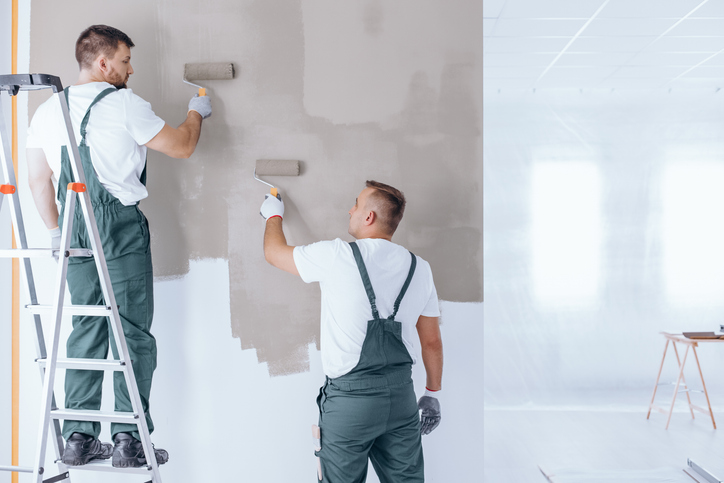Introduction
Painting a room is a satisfying way to refresh your home’s interior, but one of the most debated steps in the process is whether or not to use primer. Many homeowners want to save time and money when they paint a room by skipping it altogether—but is that always wise? The truth is, primer serves a very specific purpose: to seal surfaces, improve adhesion, and help your paint color appear even and vibrant. However, in certain situations, you can get away with painting without it and still achieve great results. In this guide, we’ll break down when you can skip the primer, when you absolutely shouldn’t, and how to make smart decisions for a lasting, high-quality finish.
1. When You Can Skip Primer on Previously Painted Walls
If your walls are already painted with a similar color and are in good condition—no stains, no peeling, and no drastic color changes—you might be able to skip primer. Latex paints bond well to clean, flat, and well-maintained surfaces. A quick wipe-down and light sanding may be all that’s needed before applying the new coat. This saves both time and money, especially if you’re just refreshing the space. However, keep in mind that skipping primer may slightly affect the final sheen or tone of the paint.
2. When Primer Is a Must for New Drywall or Bare Surfaces
New drywall or unpainted plaster soaks up paint like a sponge. Without primer, your paint job will likely look blotchy, uneven, and dull because the surface absorbs paint too quickly. Primer acts as a sealant that prepares the wall and ensures a uniform finish. The same goes for surfaces like bare wood, masonry, or skim-coated walls. In these cases, skipping the primer can lead to long-term issues like bubbling or peeling paint.
3. When Painting Over Dark or Bold Colors
Painting a light color over a dark or vibrant one without primer can lead to frustrating results. The old color may show through the new paint, forcing you to apply multiple coats. A primer blocks the underlying color and gives you a neutral base. In contrast, skipping the primer in these situations often wastes more paint, time, and effort in the long run. A good stain-blocking primer also prevents any underlying pigments or imperfections from bleeding through.
4. When Using Paint-and-Primer-in-One Products
Many modern interior paints are marketed as “paint and primer in one.” These can be effective when covering previously painted surfaces in similar shades. They are formulated to provide decent adhesion and coverage in a single step, but they’re not true replacements for traditional primer in all cases. For instance, they won’t perform well on new drywall, stained walls, or high-gloss finishes. Read the product label carefully, and understand that these combo products are best for low-risk scenarios with minor color changes.
5. When Dealing With Stains, Odors, or Damage
If your walls have smoke damage, water stains, pet odors, or other contaminants, primer is essential. Specialized primers can seal in stains and prevent them from bleeding through the final coat. Painting over these issues without primer can result in ugly marks showing up within days, or the new paint not sticking at all. Similarly, if the surface has been patched or repaired, primer helps ensure that the texture and color blend in seamlessly with the rest of the wall.
6. Primer for High-Humidity or High-Traffic Areas
Rooms like bathrooms, kitchens, or hallways experience more wear and moisture than other parts of the home. Skipping primer here may cause your paint to fail sooner due to poor adhesion or water damage. Moisture-resistant primers protect the surface and extend the life of your paint. They also prevent mildew growth and make the surface easier to clean. For high-traffic zones, a quality primer ensures durability and maintains a fresh appearance longer.
7. Time and Cost Savings Versus Long-Term Durability
It might seem tempting to cut costs by skipping primer, especially for small or low-visibility areas. But when you factor in the risk of multiple paint coats, poor adhesion, or early repainting, the savings may be lost. Investing in a primer where it’s needed ensures long-lasting results. On the flip side, when used strategically, avoiding primer on certain surfaces can reduce labor and material costs without sacrificing quality.
8. How to Decide Whether to Use Primer or Not
Evaluate the condition of the wall, the surface type, and the paint color change before deciding. Ask yourself: Is the wall clean, dry, and already painted in a similar color? Am I using a high-quality paint with strong adhesion? Is the surface stained or new? If you answer yes to most of these conditions favoring primer, don’t skip it. But if your surface is already in great shape and you’re making only a subtle color change, you can proceed without it with confidence.
Painting a room without primer can work under the right conditions, but it’s not always the best move. If you plan to paint a room that’s already been painted and is in good shape, you can often skip primer and still get excellent results, especially with paint-and-primer-in-one products. However, bare surfaces, bold color changes, and problem areas all demand proper priming. Knowing when to use primer is the key to achieving a smooth, long-lasting, and professional-looking finish. It may take a few extra steps upfront, but it ensures that your new color looks its best and stands the test of time.
Conclusion
Do you want to paint a room without primer? Trust the experts at Noel Painting Services to guide you right. Call us today at (813) 406-3196 for flawless results!
📌Noel’s Painting Services – Trusted Experts in Fast, Reliable Interior & Exterior Painting








